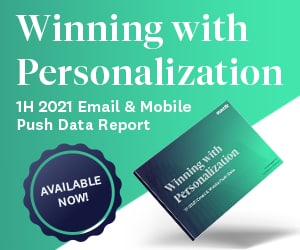 Sep 21, 2021 |
|
Good morning, Marketer, how important are the features of a new marketing tool vs. cost? Below, we dive into our MarTech Replacement survey — which you can download here — and what we found was that even in uncertain times, when companies were tightening their budgets, they also placed consideration of some important features like data management above the cost concern. Looking back over the many panels and talks we hosted at MarTech last week, I was struck by how technologies like AI for predictive analytics and digital asset management tools are being much more widely adopted. Marketers have a lot more choice among these cutting-edge solutions, so they are better equipped to find the right tool to add or replace in their stack without taking too big a chunk out of their budget. Chris Wood,
Editor |
|
| | | Performance | | | | | Oracle announces new B2B lead gen product | | Oracle today announced the launch of Oracle Fusion Marketing, part of Oracle Advertising and CX. The new product tracks account engagement with both email and advertising channels, uses AI to score leads and predict opportunity for sales engagement, then delivers the qualified opportunity to any CRM system. The offering seeks to automate the B2B lead generation and qualification process and push the outcomes directly into the systems used by sales representatives. “Salesforce automation has left sellers behind and has become about salesforce automation,” said Nate Skinner, Global SVP of Marketing for Oracle Advertising and CX (referring to CRM across the board, not just — but clearly including — Salesforce.com). “Very few traditional CRM systems actually help sellers sell. They help them track their contacts, but they don’t do things that help them get back to selling.” Modern marketing compels engagement with many different solutions within the marketing stack, and for many marketers not everything is automated. “We have to create segments manually, we have to supply content for our sellers manually, depending on the technology we often have to route leads manually,” said Skinner. “Meanwhile sellers are receiving way too many unqualified leads.” In a world where most of the buyer journey takes place as self-service, the pressure on B2B marketers to identify and deliver qualified leads only increases. “Salesforce as a category was intended to automate the work for sellers; it’s become administration. I have never met a seller that likes to use their salesforce automation system — they see it as an oversight tool for their managers. We’ve got to give them products that powers their ability to sell.” Read more here. |
|
| | | | Webinar: Your customer has evolved. So should your marketing. | | Digital-first no longer means email-first. Marketers must move beyond a single-channel marketing approach to reach B2B buyers where they are – in all channels. Join our experts as they share strategies to connect and build trust with your buyers, including how to target and identify known and unknown buyers, orchestrate cross-channel campaigns quickly and precisely, and build trust with buyers by ensuring all data is standardized, valid, compliant and marketable. RSVP Today » |
|
| | | Transformation | | | | | Serial 1 eBikes shifts gears to optimize digital assets | | eBike manufacturer Serial 1 had lots of gorgeous product and lifestyle imagery at their disposal, but they didn’t know what specific shots would resonate with their customers. They also had limited time to wait for results from a traditional A/B testing approach. To accelerate their decision-making process, they implemented Vizit, a visual intelligence platform that uses AI and machine learning to identify the components of visual content and quantify its effectiveness. The platform’s AI-driven technology helped Serial 1 determine what images resonated most with consumers. Serial 1, a standalone company that was initially launched from within Harley-Davidson, manufactures premium eBicycles. The bikes have been in development for years and were recently made available to consumers in the spring of 2021. Serial 1 wanted to quickly understand what visual content resonated with consumers, particularly in the current post-pandemic environment. “As we began marketing our eBikes, we weren’t sure which specific shots would appeal most to our customers and potential customers,” said Rex Hamilton, Serial 1’s VP of Finance and Corporate Operations. “Do they like to see the eBikes in action? Do they like to see close-ups of the sleek design that shows off our integrated internal wiring, for example? Or would they rather see wide-angle shots of the entire eBike on display? Vizit offered us a way to use technology to figure this out rather than simply guessing or testing.” Read more here. |
|
| | | | Available on-demand: 75+ sessions, solutions, and case studies for senior marketers | | The entire MarTech program is now ready for you to watch on-demand, featuring data-rich case studies from U.S. Soccer, Sony, Cinemark, and more leading brands — and a look at 50+ time-saving, profit-boosting marketing technologies that will help you make the most of your data. It’s all yours, all free, and all streamed directly to your computer. What are you waiting for? Register for free » |
|
| | | Management | | | | | Replacements: Features over cost | | In the 2019 MarTech Replacement Survey we saw a mix of homegrown, legacy solutions and commercial solutions being replaced. But in 2021 we saw a big shift. This year when we launched this survey to help us understand how the pandemic has affected marketing technology purchases, we found more than half the respondents reported moving from one commercial platform to another. On the other hand, around 30% did move from a commercial or an existing homegrown solution to another homegrown solution — so IT and DevOps teams that manage these platforms still have a role to play. But at a time when budgets were tightened, it wasn’t primarily cost that drove these decisions. Whether homegrown or commercial applications were being replaced, features trumped cost. In each case, more than 50% said the replacement was driven by better features, although around 41% did cite cost as the reason for migrating solutions. Over 70% were replacing a solution that had been in place between one and five years. The peak period for replacement (3 to 5 years) remained the same as in our 2019 survey. We drilled down further into the factors that meant most to the replacers. Because multiple choice answers were permitted, cost showed much more strongly. Clearly, respondents were prepared to cite cost as important as well as more substantive features. For better or worse, compliance and security were somewhat down the list. Read more here. |
|
| | | Quote of the day | | | | | | | “We try on a daily basis to remember to be early. Not necessarily being the first to move, but being what we call a ‘rapid imitator.’ We’re not necessarily on the bleeding edge of technology, but we do want to make sure we’re cognizant of trends and when things are changing.” Ross Moses, Senior Director, Analytics and Insights, United States Soccer Federation, speaking at MarTech |
|
|
|


